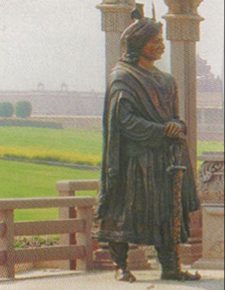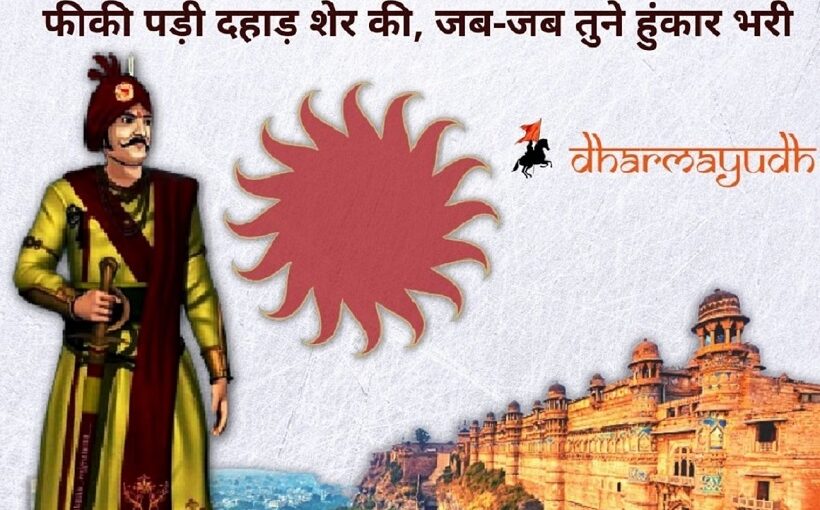In our previous article, we had covered the story of Nagabhata 1 who repulsed the Arab invasion and shielded the Indian Sub-continent from distortion.

The Gurjara Pratihara Empire established its supremacy over western India around the 8th century CE. But the Arabs continued their attacks to conquer the sub-continent. In this article, we will cover the story of another great Hindu king who badly defeated the Arabs and stabilized the Pratihara Rajput Empire both politically and economically whose name has been erased from Indian History.
Content
Background: Early History of Mihir Bhoj
Historians had suggested that the date of Mihir Bhoja’s reign started from 836 CE. He was the son of king Ramabhadra. There are several debates on the capital city of Bhoja’s kingdom but it is widely accepted that the King had made Kannauj the center of his empire.
The Barah copper plate suggests that Bhoja had established his control over Gurjarata and Eastern Rajputana by 843 CE. However, he has initially faced setbacks from the Palas Rashtrakutas and the Kalachuris.

But all these setbacks were temporary and things changed rapidly when the Pratihara king shows his true skills of military leadership.
He (Mihir Bhoja) remained determined and wanted to bring the glory of the Pratihara Empire back.
He is also known as Prabhasa, Adivaraha and Mihira. It is believed that he was a strong devotee of Bhagavati. He extended the empire and fought with the neighboring kingdoms of the Palas, Rashtrakutas, and the powerful Arabs who had captured Sindh.
Support Dharmayudh. If you like our work… DONATE HERE!
The 49 years of his reign is regarded as the golden age of the empire as Mihir Bhoj shielded the empire from the powerful Arabs who at that time were the champions of the Middle East, Central Asia, and even Africa.
Note: There is a debate among different communities who claim that Mihir Bhoj hailed from their cast. The two most prominent communities are Rajput and Gujjar.
However, Historians also claim that they have not found any proof of Mihir Bhoj’s ancestors of any non-Rajput caste. The word Gurjar in his name is derived from the area from where he ruled, which is the current state of Gujarat.
Military Campaigns of Mihir Bhoj
Bhoja and Bengal
Mihira Bhoja recovered from initial setbacks and invaded the Pala kingdom of Bengal. He gains the support of the Chedi ruler of Gorakhpur and the Guhilots. Mihir Bhoja defeated the Pala ruler Narayanapala and captured the western part of his empire.
Bhoja and Rashtrakutas
He defeated the Rashtrakuta king Krishna II on the banks of river Narmada and occupied Malwa. From here Bhoja moved towards Gujarat. Later he maintained the supremacy over Kathiawar peninsula. Extended his dominion over Punjab. Kalachuris of Gorakhpur were his feudatories, chandelles of Bundelkhand also accepted his overlordship
Mihir Bhoj and Arabs
Within a year of Bhoja’s accession, the Arabs again tried their luck to invade India from the western front. As we have mentioned above that the date of Bhoja’s accession might be somewhere in 836. It is strongly believed that during this time Irman ibn Musa became the governor of Sindh who had planned a grand invasion of Bhoja’s empire. But this attack resulted in a failure.
From 833 to 842 the Arabs were successfully driven out from Kachchha and the Caliphs lost control of Sindh in a few years. Only Multan and Mansurah remained under their hegemony.
The Arabs described that Bhoja’s empire was about 120 sq Parsangaes of Sindh.
Note: Each Parsangaes is equal to 8 miles.
How Arabs Described Mihir Bhoj
Arab chronicles of Suleiman states that the king of Jurz (Gurjara-Pratihara)
“This king maintains numerous forces and no other Indian prince has so fine a cavalry. He is unfriendly to the Arabs still he acknowledges that the king of the Arabs is the greatest king. Among the princes of India, there is no greater foe of the Muhammadan faith than he. His territories form a tongue of land. He has got riches and his camels and horses are numerous. Exchanges are carried on in his states with silver in dust, and there are said to be mined in the country. There is no country in India that is safer from robbers. ”
Al Masudi of Baghdad who visited India during the 10th century referred to Bauura (Bhoja) as the lord of the city of Kannauj and as one of the kings of Sindh. He further adds that the king had large armies in all four directions i.e. East, West, North, and South.
He also mentioned that Bauura the king of Kannauj is an enemy of Balhara (Vallabha Raja, the title of Rashtrakuta emperors). He adds Bauura the king of Kannauj has four armies according to the four quarters of the wind.
Each of the numbers 700,000 or 900,000 men. The army of the north was against the prince of Multan and with the Muslims, his subjects were on the frontier. The army of the south fought against the Balhara. Bauura is rich in horses and camels and has a large army.
It gives us glimpses of Mihir Bhoj’s leadership. It is clear that he wisely protected his empire from internal and external aggression. Historians gave this great king the credit of stopping the advance of the Arab hordes.
It is due to Bhoja’s audacious military leadership that he made the defeated Arabs follow the order of the feudatory Chahamans of Bhoja.
Bhoja extended his empire beyond Indus. At his peak, the empire reached to Narmada river in the south, the Sutlej river in the northwest, and Bengal in the east. It extended over a large area from the foot of the Himalayas up to the river Narmada and included the present district of Etawah in Uttar Pradesh. He maintained a regular standing army which was paid regularly.
The last known date of this great Hindu king is 882 or maybe 888 CE. After him his son i.e. Mahendrapala succeeded him. But the ode of this Hindu king remains unsung among the new generations.
It is up to us to teach the right side of Indian History and those heroes who gave their everything for the sake of this subcontinent.
LIKE WHAT WE ARE DOING? DONATE TO DHARMAYUDH
If you support what we are doing and would like to contribute to help us grow and reach more Indians to teach them more about such forgotten historic Indian Heroes and stories, please consider donating any amount. It will help us grow.

